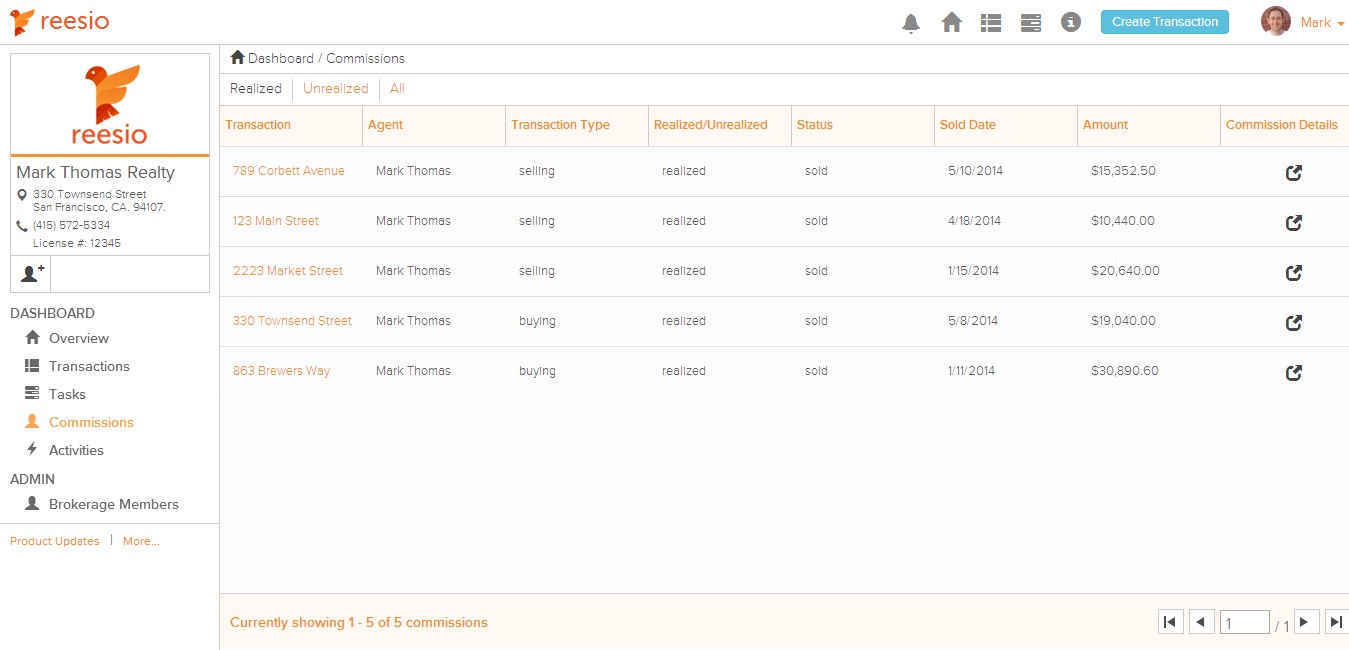Reesio, a startup that made its transaction management platform available for free in October, has rolled out a slew of new features designed to attract large brokerages and multiple listing services to the tool.
Founded in January 2012, the San Francisco-based tech company originally aimed to help for-sale-by-owner sellers advertise their properties on local MLSs, but soon switched its business model to offer its platform exclusively to real estate agents.
Reesio launched a broker version of its platform in April 2013 and later that year raised $1.1 million in additional seed funding from investors — money the company said it would use to tackle listing accuracy in the real estate industry.
Since November, Reesio has more than doubled its customer base from about 2,500 users — agents, brokers and transaction coordinators — to more than 6,000 at the end of April.
The new features announced today are designed for brokerages of all sizes, but Reesio co-founder and CEO Mark Thomas anticipates they will attract larger brokerages with more that 500 agents, as well as MLSs — those who may be tired of using older systems that lack modern design and user interfaces, he said.
“It used to be that enterprise software had to look ugly in order for it to get buy-in from the (chief technology officer) of a large organization,” Thomas said in a statement.
“Now, you see a bottoms-up approach where individual agents are using a product, loving it, and recommending it to their CTOs.”
The new features allow brokers to manage all transactions for users within their firm in one centralized dashboard. They can view graphs and charts for key metrics such as transactions by status, upcoming property closings, transactions created in the last 30 days, and what tasks need to be completed or approved.
Reesio has also added commission tracking, allowing brokers to enter commission details for each transaction by percentage or dollar amount as well as the commission split. The platform automatically calculates the commission for a particular deal and changes the commission to be based on the contract price rather than the list price when a property goes into contract.
Reesio is considering connecting the platform to a brokerage’s accounting software in the future, Thomas said.
The new dashboard also includes Facebook-style notifications letting users know, for instance, when documents have been shared or signed or when an offer has been received or when the due date of a particular task has changed. When a user clicks on a notification, Reesio takes him or her right into the relevant document or task.
“In sticking with the theme of keeping our product social and similar to products like Facebook that people use every day, we’re continuing our quest to be transaction management for the modern real estate professional,” Thomas said.
“There are a lot of ugly, clunky real estate technology products out there. Users need more than just functionality. They want and need a beautiful, social product that mirrors the other ones that they use outside of their jobs.”
Reesio’s goal is to become a “one-stop shop” for real estate professionals, Thomas said. A recent survey by consulting firm WAV Group found that real estate brokerages are hungry for technology platforms that integrate with each other.
To that end, the company plans to roll out paid features that agents and brokers can choose to upgrade to in the next two or three months. This will include a customer relationship management tool to manage leads, as well as a third-party vendor program, Thomas said.
Reesio also plans to dive into listing syndication. Real estate pros will be able to syndicate to the major portals — Thomas declined to specify which yet — and send them real-time data directly from the transaction.
Currently, individual agents may not always have a choice over where their listings are displayed, Thomas said.
“Sometimes the MLSs decide, sometimes the brokerages decide. By not having to re-enter the data a second time and having control over where it goes, that’s a tremendous value-add,” he said.
That challenge of re-entering data is key in another aspect of Reesio’s platform: claims that its data is more accurate than that on Zillow, Trulia and realtor.com.
In a study Reesio conducted between August and February, the company analyzed listings details such as price and status on about 3,000 of the 6,300 properties in its system and compared them about once a week to the information appearing on Zillow, Trulia and realtor.com. Reesio found that at least one piece of information was incorrect on each of the sites 52 percent of the time.
With a caveat about the smallness of the study, Thomas said, “The reality is clear that transaction management is the path to getting the most accurate data in real time and being able to offer the most customized user experiences.”
He emphasized that the problem wasn’t necessarily with the portals, but rather that the MLSs feeding them the data are not as up-to-date as the data submitted to Reesio.
“(B)rokers and agents are in Reesio every day managing all aspects of their job. They don’t have time to go to their MLS’ technology platform and update the listing in real time, and a lot of the technologies that the MLSs use are not user-friendly, so it’s a pain for brokers (and) agents to update their listings in the MLS in the same real-time fashion that they’re doing it within Reesio,” Thomas said.
“Plus, because our users oftentimes will set up prelisting workflows and checklists of things to do, and because they generally sign the listing agreement with the seller right in our system, we’ll oftentimes get listings before the MLS does. All of this means that we generally have more accurate statuses and listing prices than even what the MLSs have.”







